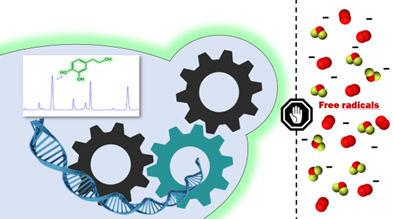Currently, hydroxytyrosol is the only polyphenol for which an increase in consumption is recommended by the European Food Safety Authority (EFSA), due to its numerous health benefits including antioxidant and cardioprotective properties. Industrially, this compound is primarily obtained from olive wastewater, a side product generated in the production process of olive oil. The main problem faced when extracting hydroxytyrosol through these means is the inefficient performance obtained. Additionally, the purity of this hydroxytyrosol is also low, requiring subsequent extraction operations that complicate and increase the cost of the process. These factors have created a need to develop new alternative production methods that allow a more efficient obtention of hydroxytyrosol at an industrial scale.
Regarding this, researchers from the Institute of Agrochemistry and Food Technology (IATA) have developed a novel recombinant strain derived from the yeast Saccharomyces cerevisiae for the improved production of hydroxytyrosol. The researchers have developed a recombinant strain derived from the yeast Saccharomyces cerevisiae that allows the production of hydroxytyrosol with a high degree of purity and optimized yield. The developed technology allows for the obtention of this high-value compound employing basic substrates such as glucose and ammonia.
This improved obtention of this molecule has been achieved through the genetic modification of a strain using metabolic engineering techniques that enhance the production of hydroxytyrosol. The strain has been genetically altered to optimize the metabolic pathway leading to hydroxytyrosol synthesis.
Moreover, the strain design considers the possibility of using residues from the agri-food industry, such as orange pulp or concentrated grape must, for the obtention of hydroxytyrosol. This enables the valorization of these waste products by using them as a source of carbon and nitrogen for hydroxytyrosol production.
Overview of the developed technology for hydroxytyrosol obtention
The strain has already been optimized at the laboratory scale for the production of hydroxytyrosol, reaching concentrations of 1 g/L. Currently, the researchers are working on scaling up the production of hydroxytyrosol to an industrial level using the developed strain. A PCT patent application (WO2022112627A1) was submitted in 2020. Furthermore, they are also carrying out the optimization process for other strains at the laboratory scale to produce different bioactive compounds, such as serotonin and melatonin.
Benefits:
- New alternative production method for a high-value compound
- Hydroxytyrosol production using the developed strain avoids the use of complex chemical processes
- The strain enables the production of hydroxytyrosol using inexpensive and commonly available substrates
- The strain allows for an increase in both the yield of production and the purity of the final product
The represented institution is looking for a collaboration that leads to commercial exploitation of the presented invention.
Institution: Institute of Agrochemistry and Food Technology (IATA)
TRL: 4-5
Protection status: Patent Application
Contact: Carlos G. Gredilla / c.gredilla@viromii.com


